


04/04/24 TO 01/06/24







04/04/24 TO 01/06/24



Welcome to the exhibition «Wealth & Adornment», a fascinating exploration of the splendour of monetary instruments and body adornments of the peoples of Oceania and the Far North. In this catalogue, we invite you to dive into a world where wealth is measured in much more than coins or bank notes and where magnificence is revealed through the ornaments that adorn the body
Oceania and the Arctic, vast expanses of land and sea, are home to an extraordinary diversity of cultures, each with its own traditions, beliefs and modes of artistic expression. In this exhibition, we have gathered a selection of exceptional objects that testify to the material wealth of these peoples From precious shells to colorful beads, from bright feathers to carved bones, each piece presented in this exhibition tells a unique story These objects were much more than mere possessions ; they were symbols of status, markers of identity and witnesses of ancestral traditions
Monetary instruments, whether made from shells, sperm whale teeth or other natural materials, were used to facilitate trade and social exchange, but they were also loaded with important symbolic meanings They represented the wealth and power of their owners Body adornments were much more than mere fashion accessories They were manifestations of beauty, markers of social status and channels of artistic expression Each bead, each feather, each engraved pattern had its own deep cultural significance, conveying complex messages about identity and belonging
In this exhibition, we invite you to let yourself be carried away by the beauty and diversity of these extraordinary objects Explore the meticulous details of their manufacture, meditate on their symbolic meanings and let yourself be impregnated by the creative spirit and cultural richness of the peoples of Oceania and the Far North.
«Wealth & Adornment» is much more than just a collection of art objects ; it is a celebration of human creativity, cultural diversity and timeless beauty that transcends geographical and temporal boundaries. We are honored to share these treasures with you and hope that this exhibition will inspire and amaze you as much as it has inspired us


PNG, Melanesia
Cassowary feathers, rattan Ø 45 cm. 19th-20th century Ex Georges Liotard, Marseille. Two labels are attached to the base:
1) “Masque porté par les Jeunes Initiés de la Tribu « WARAPU » (Berlin Hafen ; Nlle Guinée ALL) Vannerie et longs Brins aigrette oiseau de Paradis.”
2) “A mask made of a ring of cords and cut pearls; with tufts of bird of paradise plumage.”



Feather circle or mask. The object consists of a circular woven rattan ring to which cassowary feathers are attached. The mask is presented in its original glass case

Morovo region to Collingwood Bay region, Oro region, PNG, Melanesia Rattan, fiber and wild pig (Sus scrofa papuensis) tusks.
20 x 19 cm
19th-20th century
Acquired in 1996 from Bernd Schulz (1944-2020), Kamp-Lintfort.
U-shaped face ornament Worn vertically around the neck, it helps the warrior turn into a wild pig, which is a powerful and dangerous animal and clan emblem.

Marquesas Islands, Polynesia Sperm whale tooth (Physeter catodon). 10 x 8.2 x 3.8 cm Early to mid-19th century Ex Étienne Cros, Paris, acquired in a flea market in France
Large and rare ha’akai ear ornament This type of object was worn by high-ranking men Here, the spur is divided into two points, each adorned at the end with a large tiki head One of the tips is also decorated with a tiki torso. This lateral figure is unusually large, carved in three dimensions with a large head and hands on the
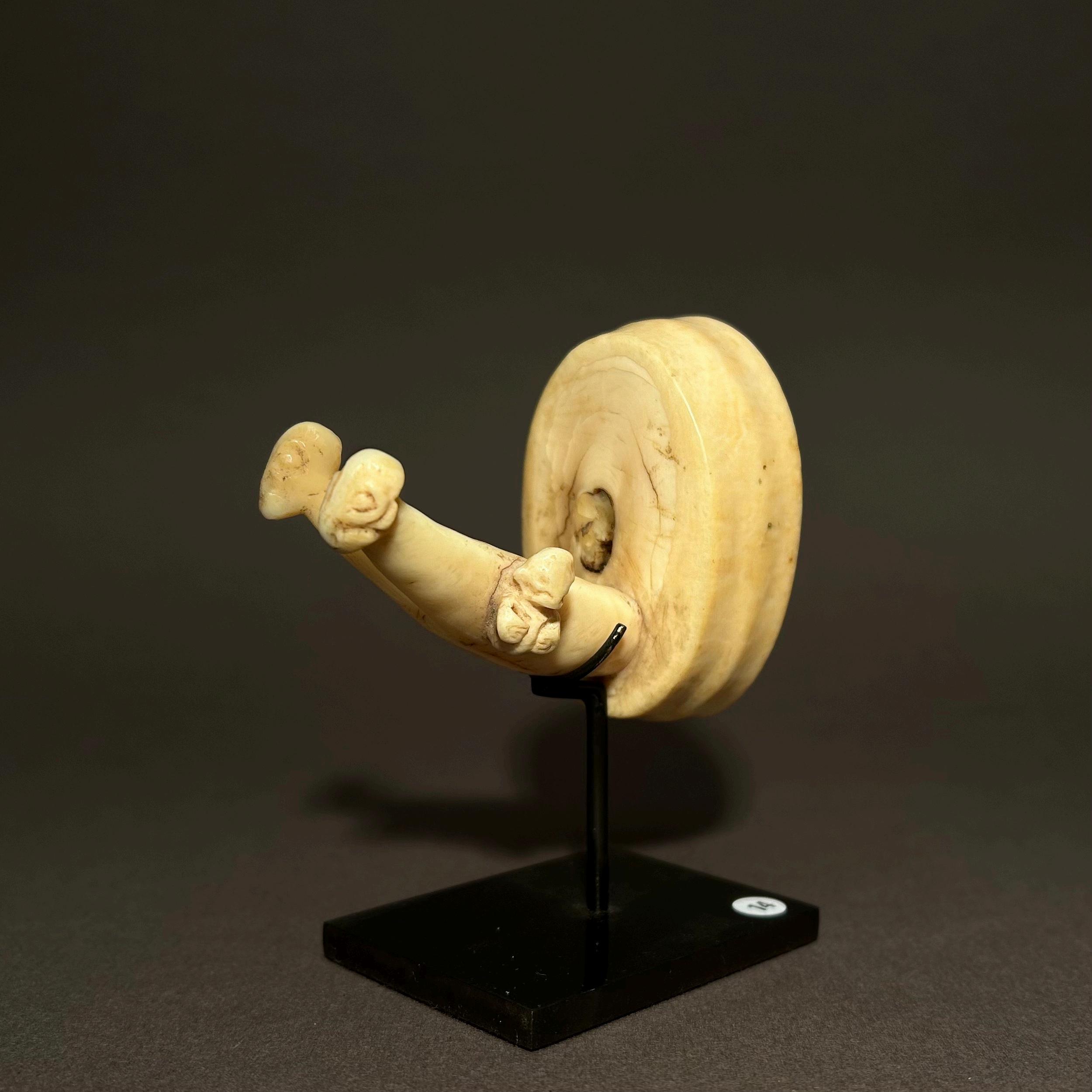
Murray River, Southern Australia. Fiber, resin, pigments, kangaroo (Macropodidae sp ) lower incisors
27.5 cm (without cord) x 4.7 cm (without teeth).
From a group of objects collected at the end of the 19th century Pub : Meyer, Anthony JP WALKABOUT - the Early Art of the Australian Aborigines/l'Art Ancien des Aborigènes d'Australie - and a Selection of Early Eskimo Art/et une Sélection d'art Ancien Eskimo. Galerie Meyer, Paris. 2012, p 37, fig 52

Extremely rare headband made of resin-coated woven fiber A series of three kangaroo teeth hang from each side of the ornament.
See a comparable example in the collections of the National Museum of Victoria (Australia), Inv X1576
Lower Sepik region, PNG, Melanesia fiber and cloth, vegetable fiber, nassa shells and clam shell, coconut shell, dog’s teeth and red ochre
A patina of wear with repairs and missing parts consistent with use (one attachement missing) 24 x 25 x 11 cm.
Probably made between 1930 and 1950
Purchased from John Gabo, chief of the Zamengen clan, from Awar village on the East coast of the mouth of the Ramu River. Kumen language group. The mask is called u’panim and/or kumen Information supplied by Joel Gauvin & Angel Bottaro, Australia
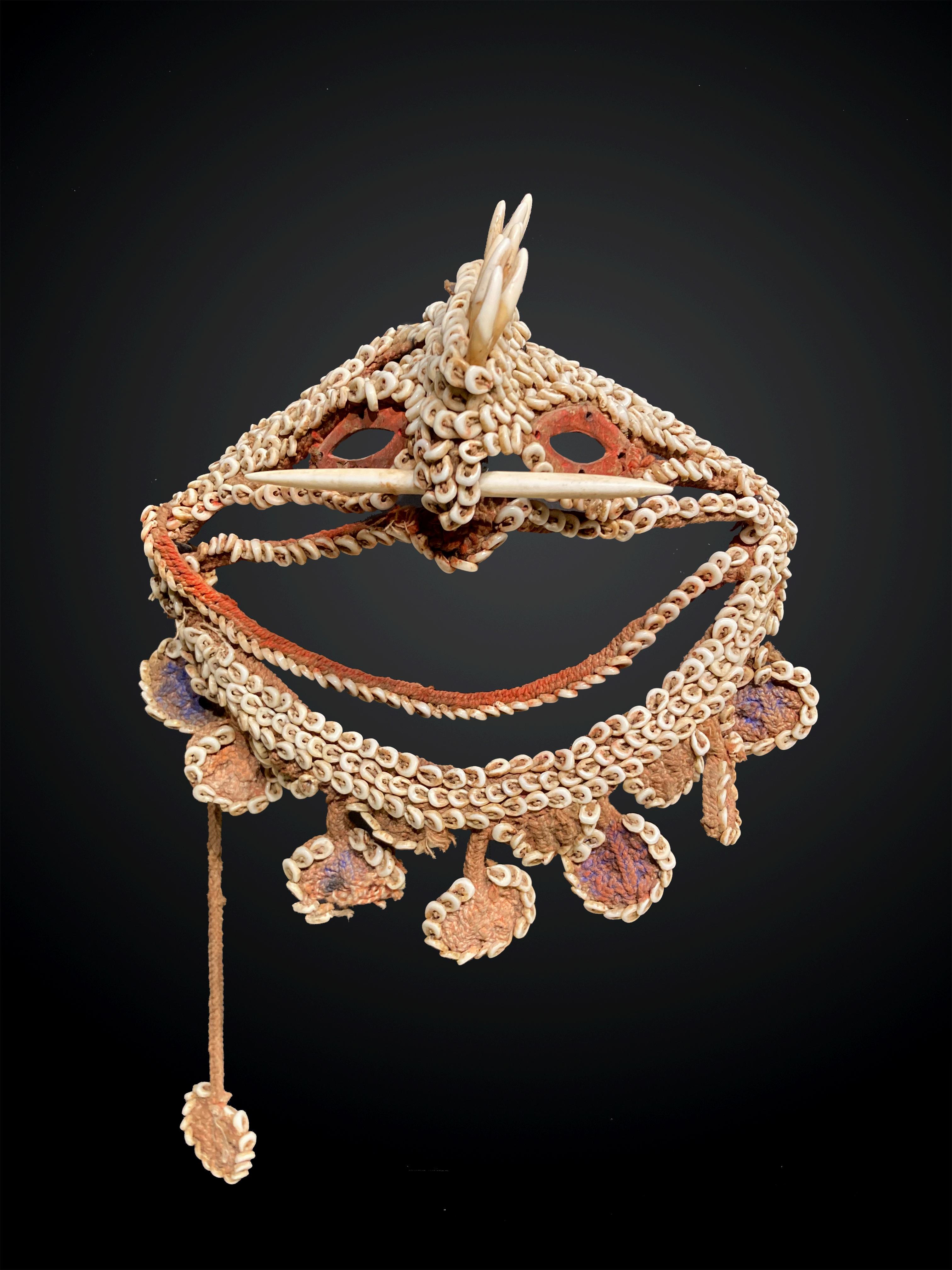
A rare form of mask or facial ornament featuring a face with a broad smile topped by a crest. A nasal ornament made from a piece of cut and polished Giant Clam shell is inserted through the septum This type of mask is not well documented and its exact use remains relatively mysterious - it seems that it was possibly worn during naven ceremonies
Makira Island (San Cristobal Island), Solomon Islands, Melanesia Giant Clam shell (Tridacna gigas) with a beautiful patina due to age and use. ø 5.3 cm (left) ø 5.1 cm (right). 19th century or earlier
These superb and rare earlobe ornaments have been carved from a giant clam shell with radiating lines and holes Such ornaments were worn by men or women with stretched earlobes They were called ulawa or eho and were worn on Makira Island and in the South of Malaita Island Grulke (2022, p 295) explains that “examples from various museum and private collections show a remarkable consistency of design”. A fiber thread was inserted through the central hole of the first element, then went under the chin up to the hole of the second element. This type of ornament can be seen on the large Ataro figure from the Charles Ratton collection, now at the Fondation Gandur pour l’Art
Ref:
Ivens, Walter G : DICTIONARY AND GRAMMAR of the LANGUAGE OF SA'A AND ULUWA, SOLOMON ISLANDS
The Carnegie Institution of Washington, 1918, PL. 8A.
Grulke, W , Adorned by Nature: Adornment, Exchange & Myth in the South Seas, At One Communications, 2022, Neich, R and F Pereira, Pacific Jewelry and Adornment, University of Hawai'i Press, 2004 Waite, D. and K. Conru, Solomon Islands Art: The Conru Collection, 5 Continents, 2008.






Asmat, probably Otsjanep region, Irian Jaya, Indonesian New Guinea, Melanesia Pig bone (leg) with a superb golden patina 12 3 x 3 3 x 1 9 cm 19th-20th century.
Ancient nose ornament or otsj. The openwork tube is placed through the laterally pierced septum. The carving of the ornament forms a series of struts that form a highly stylized representation of a human body This type of object was worn by experienced headhunters.
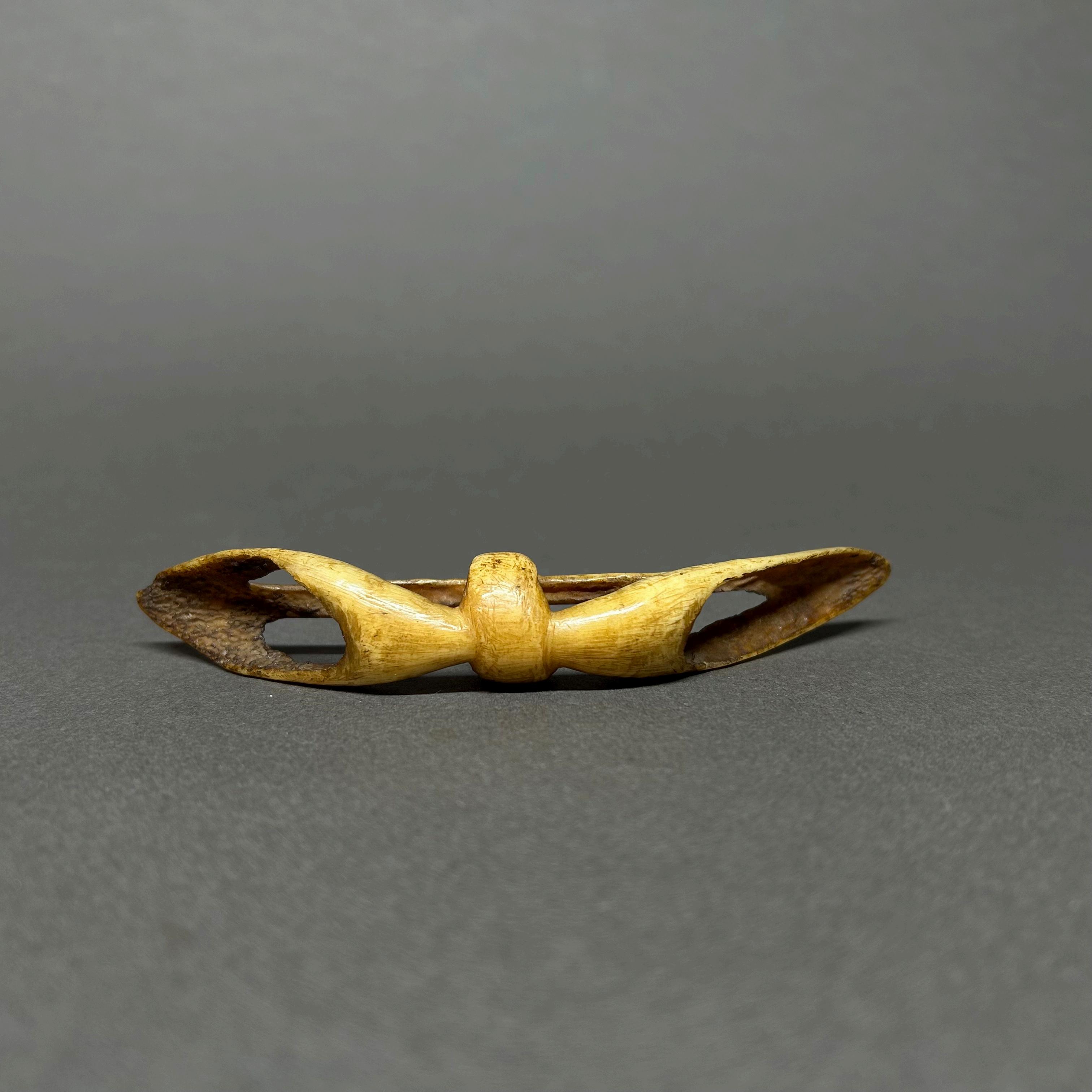
Possibly Wara Kar village area, Wahgi Valley, Western Highlands, PNG, Melanesia
Conus shell, resin, ochre, beetle wingcase (Lomapteria jorkiana?)
Object: ø 8 cm. Box: ø 11.5 cm.
A label describes it as coming from Wahgi (valley) and the object is accompanied by a copy of a legal complaint relating to this object for a loan worth 340 kina in 1983
Ex Chris Boylan, Sydney.
Rare nose ornament consisting of a shell disk with a section of bottle-green beetle wing casing in its center
The ornament has been placed in an old tobacco box and protected with an old torn bilum (bag).
The description of the British Museum example reads: “Shell nose ornament (pokei ngumb: literally pokei nose), purchased from Mangiye, of the Sekakadu, Akilkanem Ogulkanem sub-group. The black marks around the U-shaped cutout at the top of the object come from “banz”, a variety of beeswax used to attach the shell in the septum.” For an account of the history of the collection to which this piece belongs, see Paradise: portraying the New Guinea Highlands by Michael O'Hanlon (British Museum Press, 1993)



Yap Island, Caroline Islands, Federated States of Micronesia, Micronesia
Mangrove wood (Rhizophora sp.) with matte patina.
46 x 9 cm
19th-20th century
Ex Michel Thieme, Amsterdam;
Ex Oscar van Weerdenburg, Netherlands.
Beautiful wooden hair comb with 20 finely carved teeth, held together by 4 side pins. The 4 central and outer teeth spreading apart at the ends give the comb a curved shape. These elegant and refined combs were very important ornaments, revealing the wearer’s social rank


Village of Tambul, Western Highlands, PNG, Melanesia.
Bush twine (inner bark of the Gnetaceae plant), cassowary feathers, beads, resin and red ochre
Dimensions as photographed 51 x 32.5 cm.
First half of the 20th century
Ex JOLIKA - Marsha & John Friede, New York (one of two examples in the collection);
Ex Alexandre Bernand, Paris/Lisbonne.
Extraordinary men’s headband called mamu nofi The fiber band is adorned with two side roundels made of glass trade beads, from which a set of cassowary feathers in the shape of a bird’s wing descend on either side The headband was tied around the head, the circular elements at the temples, the “wings” hanging over the sides of the cheeks to hold back the hair (which was traditionally worn long in Rasta-style dreadlocks and often braided). This type of object has been reported elsewhere to be worn with the “wings” upright to hold the headdress in place While headbands and hats made from cassowary feathers were widely used in the Highlands, this particular type has disappeared a long time ago. When an object of the same type was shown to Kamano informants, it was recognized and named as a mamu nofi, an item which used to be worn by men both in war and during certain ceremonies
See the other example from the JOLIKA Collection (ex-coll Elizabeth Pryce, Sydney, then JOLIKA Collection No JF-A57) in NEW GUINEA HIGHLANDS - Art from the JOLIKA Collection. Fine Arts Museums of San Francisco / Del Monico Books / Prestel, New York, London, Munich

Gogodala, Fly River region, Gulf of West Papua, PNG, Melanesia. Woven fiber, rattan, wood, feathers and pigments
34 x 44 cm (with feathers) and 29.5 x 27 cm (without feathers).
Ex Galerie Voyageurs & Curieux, Paris; Ex Pieter Lunshof, Paris/The Hague
War or painale headdress consisting of a braided fiber frontal element mounted on a wooden frame and adorned with feathers. The geometric decoration is two-tone and in champlevé. The two edges of the headdress are each adorned with an imposing fringe of cassowary feathers These war headdresses are also sometimes worn at dances and festivities in place of dance headdresses - which are almost pyramid-shaped and are worn on the head rather than around the forehead like those for combat
Ref: Crawford, Anthony: AIDA - Life and Ceremony of the Gogodala. Robert Brown & Ass., Bathurst, 1981.


Abelam, eastern Sepik region, PNG Wood, rattan and feathers (rooster).
76 x 5 x 3 cm
Early 20th century.
Ex Ulrich Kortmann, Dortmund ;
Ex JOLIKA, Marcia and John Friede, New York ;
Ex Marc Assayag, Montreal ;
Ex Michael Hamson Oceanic Art, Palos Verdes, CA ;
Ex Cathryn Cootner, Sonoma, CA ;
Ex Eugene Manning, New York
Pub Michael Hamson Oceanic Art, 2016, San Francisco, N° 22, page 49

Santa Cruz Islands, Solomon Islands, Para-polynesia
36.5 cm / 39.5 cm. 20th century.
Ex Roger Boulay, Torcy.
Pair of wealth sticks or noaipu (noveapu) and used both as hair ornament and indicators of wealth Each stick consists of a thin segment of palm wood covered with the red feathers of the Myzomela cardinalis and a tuft of white down at the end Indicators of wealth reserved for chefs, these sticks were worn in the hair during the nelanga nelo dance and at certain ceremonies The birds whose red plumage was used to adorn the sticks were not killed: a tree branch was brushed with sap from the mulberry tree which served as bird-lime (glue) to capture the animal and allow the removal of the necessary feathers before releasing it.
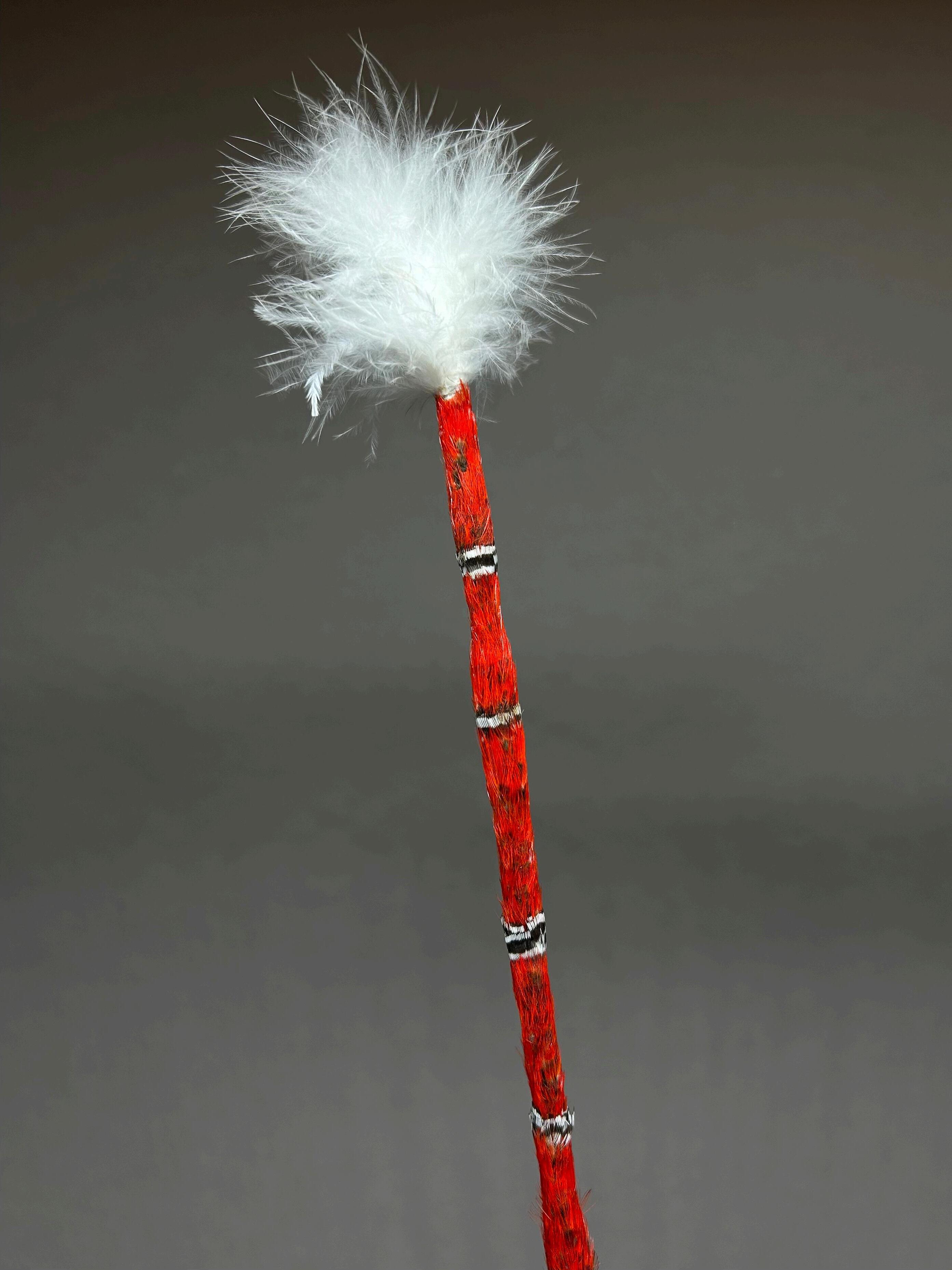


Marind Anim, Bian River region, southeast Indonesian New Guinea, Melanesia
Lower incisors of Macropodidae sp and canines of Canis lupus familiaris with plant fibers
35.5 cm with fibers.
19th-20th century
Ex A. Pattison, New Zealand.
Pub: Meyer, Anthony JP: OCEANIC ART / OZEANISCHE KUNST / ART OCEANIEN Könemann Verlag, Köln 1995, fig 76, p 92
Extremely rare warrior necklace featuring 44 kangaroo teeth and 4 dog teeth on a woven fiber band

Saint Matthias Islands, Admiralty Islands, Bismarck Archipelago, PNG, Melanesia.
The insect whose leg shells were used to make the object has not been formally identified. It could be Sternocera aequisignata or Lomapteria jorkiana
Three-strand necklace with Victorian clasp 33 cm (max. length). 19th century
Exhibition / Publication: Monnaies & Merveilles. La Monnaie de Paris, Silvana Editoriale, Milano, 2022, p 130
Necklace made from sections of green iridescent beetle legs These necklaces were worn by men and often used as currency.
See similar example in the British Museum collections: inv. N° Oc1949,01.2.

Ref:
H Nevermann: "St Matthias Gruppe", Hamburg Südsee-expedition 1908-1910, p 74
A. H. Quiggin: "Survey of Primitive Currency", p. 130-131 and plate, p. 184.

Tolai people, Gazelle Peninsula, New Britain, Bismarck Archipelago, PNG, Melanesia.
Nassa shells (Nassarius arcularis jonasii), rattan, bush twine, plant fibers, fabric, with a beautiful patina of age and use.
35 x 32 x 2 cm
19th-20th century
Ex private collection, Netherlands (acquired from Dutch tribal art dealer Frans Faber in December 2023)
Superb midi (or middi), a prestigious neck ornament in the form of a large breastplate covered with small shells These ornaments were worn for ceremonies and fights
This large ornament, worn as a necklace, is composed of 14 curved rattan rods wrapped in cords; the rods are attached to each other to form a flat, concentric necklace. The top is decorated with 14 rows of nearly two thousand nassa shells The fastening system at the back of the collar, wrapped in red cloth, seems to indicate that the object was worn for a long time by its owner, as the fastening is complex and apparently permanent For Tolai men, the midi breastplate was an ornament of distinction in combat against the adversary, but it could also act as an amulet that could offer magical protection
As early as 1906, a Westerner visiting New Britain noticed that these objects were no longer being manufactured, and that a collector might consider himself lucky to find one in good condition, and would have to pay a high price for it.


Mogara village, Pak Island, Admiralty Islands, Bismarck Archipelago, Melanesia.
Dog-teeth, European colored glass beads, bush fiber 57 x 10 cm 19th-20th century.
Provenance: Collected during the Korrigane expedition, 1934-1936. Deposit n° of the Musée de l'Homme:
D 39 3 634 End of deposit in 1960/61 Sale of the Collection Océanienne du Voyage de la Korrigane, Hôtel Drouot, Paris, Maîtres Maurice & Philippe Rheims, Jean Roudillon - expert, December 4 & 5, 1961
Important currency collar or lehemui. Most of the 78 dog canines have been engraved with geometric motifs using an iron point. They were mounted in sets of 3, 4 or 5 on a band of plant fibers adorned with blue, white and red imported pearls
"This currency is used for ceremonial exchanges during weddings and mourning ceremonies Once its ceremonial use is over, it reverts to being a simple ornament worn as a necklace"
See other Korrigane pieces collected with this necklace and acquired in 1961 by André Breton (now exhibited on the "Mur André Breton" at the Musée National d'Art Moderne, Centre George Pompidou: Guayan earring (Field no.: 1247/D.39 .3.624) made of boyap trade pearls and gamui dog's teeth and muesmues seeds (indigenous currency), and the nose pendant (Field no : 1278/D.39.3.653) consisting of 18 lemui-engraved dog's teeth, a muesmues seed and a boyap trade pearl, all mounted on a kap string.
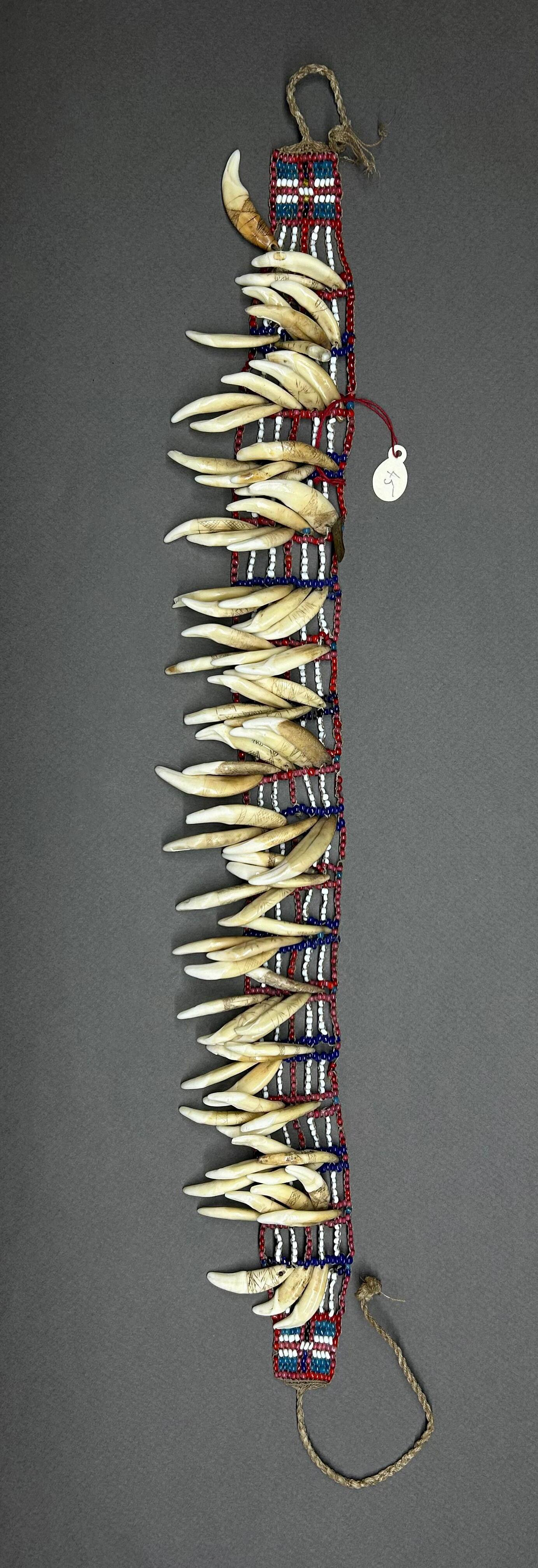


Punuk culture, St Lawrence Island, Bering Strait, Alaska. Mineralized walrus tusk (Odobenus rosmarus divergens), cord and glass beads with a beautiful patina of age and use 10 x 2 cm (length 32 cm)
Punuk c. 400-900 A.D..
Collected on St Lawrence Island by Kenneth Pushkin in the summer of 1978
Ex private collection, United Kingdom
Archaic bucket, bag or box handle decorated with stylized animal heads (perhaps wolves or foxes) at both ends. The body of the handle is decorated with intricately carved and incised geometric designs The handle has been pierced three times to facilitate attachment. Discovered in the 20th century by the Eskimo inhabitants of St. Lawrence Island, the object was transformed into a necklace by the addition of a braided string and two blue glasspaste trade beads
Fiji, Polynesia.
Pig tusk, vau (Hibiscus tileaceus) and glass beads
37 cm, pendant: 11 cm.
19th century
Former collection of the artist John Erskin Grant (1884-1957), Victoria, Australia.
Pig tusk necklaces were an important part of ceremonial, dance and war attire In the late 18th and early 19th centuries, glass beads became status markers, and the necklaces to which they were attached were worn only by chiefs. Throughout the Pacific region, pigs were valuable currency, and their tusks (especially those that had reached a full circle) functioned as indicators of an individual's wealth, strength and influence
John Erskin Grant was the art master at the Daylesford Technical School in Victoria, Australia Following the destruction of the French town of Villers-Bretonneux in the First World War, he was commissioned to carve wooden panels depicting Australian flora and fauna for the local school, which had been rebuilt with funds donated by the citizens of Daylesford. With his wife, they owned the Hallow Bank guest house at No 6 Harts Lane in Daylesford from 1905 to 1955 After his death, Mrs Grant continued the business until the early 1960s Around 1906/1908, Grant had purchased a set of Fijian artifacts (including this necklace) from a passing traveler He had displayed the objects in the billiard room of the guest house, where they remained until Mrs Grant's death and the hotel's closure
See a similar example in the collections of the Musée des Confluences, Lyon (formerly Galerie Meyer), and those of the Museum of Fiji, Suva
Ref:
Phelps, Steven: ART AND ARTEFACTS OF THE PACIFIC, AFRICA, AND THE AMERICAS THE JAMES HOOPER COLLECTION Hutchinson & Co. LTD. and Christie's, Manson & Woods, London, 1975.

Yahray region (former Digul River, southern I Calabash, feathers, se Provenance: Collected around 1940-1950 and possessions
Ex Maurice Stevens, N
Important headhunter's language of the Yahra The object may repres fringed skirt made of J by the most distinguish adorned with several p were made by tribal el batik-jamé, a feast org
There were four levels headhunters, the ramo a warrior who had succ headhunts. The others oana for at least 15 vic was gouwa.
See a similar but mis-id mit den Ahnen by Konr fig a, p 150, INV N° N examples are in the co Branly-Jacques Chirac Paris and the Wereld M collection of Ursula & collection, New York, a


Fiji, Polynesia
Sperm whale tooth with superb golden patina (traces of wear and age) and coconut fiber (sennit).
Tooth: 17 5 x 7 x 6 cm; with necklace: +/- 48 cm total 18th-19th century.
Bears an old inscription in iron gall ink: "Présented to K S Lynch, August 1907"
Exceptional polished sperm whale tooth or tabua (or tambua) with its braided coconut fiber collar and an old ink inscription. The tabua was an important cultural element in Fijian society. These objects of atonement and status were traditionally offered during sevusevu ceremonies, and played an important role in negotiations between rival chiefs. The deceased may also have been buried with their tabua, as well as their war clubs and even their strangled wives, to help them in the afterlife Originally, the few teeth available came from a few beached sperm whales and from trade with neighbouring Tonga (where the tabua may have originated) Later, in the early 19th century, thousands of sperm whale teeth, as well as false teeth made from elephant ivory and walrus tusks, were imported to the islands
Abelam - North Coast (?), Melanesia Fiber, nassa shells (Nassa jonasii), and a cowrie she 40 5 x 9 x 5 cm 20th century.
Remarkable stylized phal featuring a braided fiber e with nassa shells and mo white "porcelain" shell.

Probably Santa Cruz Islands, Solomon Islands, Parapolynesia
Giant clam shell (Tridacna gigas) 5 cm 19th-20th century.

Small, perfectly circular kapkap or pectoral pendant, finely engraved in four segments
The bands of serrated motifs are reminiscent of the tortoiseshell elements on Ndende Island kapkap.


Coastal region (?), PNG, Melanesia
66 x 4.5 cm.
20th century
Belt decorated with a geometric pattern of black seeds and white nassa shells
Admiralty Islands, Bismarck Archipelago, PNG, Melanesia Shells, seeds and fiber.
65 x 42 cm 19th-20th century.
Provenance: Collected in the field by Dr Albert Hahl, Governor of German New Guinea between 1896 and 1914; by descent. See the Hahl, Phebe & Richard Parkinson photograph album for two other aprons from the Hahl collection. Man'sceremonialapron
Men's ceremonial apron composed in its upper part of a woven fiber belt with five loops incorporated in the weave and two registers of Job's tear seeds The lower part is composed of five vertical registers. The lower fringe is made up of vertical rows of shells, each ending in a halfseed attached to fibers


Admiralty Islands, Bismarck Archipelago, PNG, Melanesia. Porcelain or white cowrie shell (Ovula ovum), black pigment
7 x 3.9 x 3 cm. 19th century
Ex Peter Hallinan, Gold Coast, N° H920.
Very rare penis or mana ornament The shell, decorated with numerous geometric engravings, has a beautiful patina due to age and prolonged use
216 x 42 cm 20th century.

Maori, New Zealand, Polynesia
Flax (Phormium tenax or Phormium colensoi) - harakeke and wharariki respectively in Maori
170 x 107 cm.
19th century
Provenance:
Ex Dr. John Rabe (dentist) in the late 1880s; formerly on deposit at the Oakland Museum, California, Inv N° 091881 (?) ; Ex Lillian & Leo Fortess, Kanehoa Bay, Hawaii ; Ex private collection, by descent, Amherst, Massachusetts
Exhibited at : Columbian Exhibition, Chicago, Illinois, 1893, N°04672.
Rare (and possibly unique) hand-woven shoulder cape, decorated with oblique lines in high relief and surrounded by fringe






Santa Cruz Islands, Para-Polynesia. Wood with dark, polished patina 23 x 12 5 cm 19th-20th century.
X-shaped amulet, or charm, also described as a unit of measurement accompanying tevau or feathered urrency-rolls. These objects, whether geometric as shown here, or zoomorphic or avimorph, are usually ched to the outside of pandanus leaf nvelopes containing tevau currencies when these are stored between ransactions A square, pierced peg is ved on the back of of the charm with hich to attache it to the envelope and secure it in place

Santa Cruz Islands, Para-Polynesia. Cardinal myzomela feathers, fiber, shells, organic matter. 80 cm (as mounted)
19th century

Provenance: Collected in the field by the Reverend Richard Blundell Comins (1848-1919) probably in 1878 when he was posted to the Santa Cruz Islands as a missionary with the Anglican Melanesian Mission. Acquired at the sale of the Comins family estate at Woolley & Wallis, Antiquities, Precolumbian & Tribal Art - February 10, 2015, lot 627
Exhibition / Publication: Monnaies & Merveilles La Monnaie de Paris, Silvana Editoriale, Milano, 2022, p 1128/129

A superb wedding currency or teau (tevau) made from a long strip of composite fiber covered with thousands of red feathers from the Myzomela cardinalis bird Up to sixty thousand feathers were used to make a complete teau These feathers were taken from around ten thousand birds, as each one only provided around six to ten red feathers The fiber strip that serves as the base, and to which lines of shells are attached, is wound on two cylinders of bark The center of this long strip is indicated on the reverse by an interlaced pattern in black fiber
Central Highlands region, PNG, Melanesia Barton's echidna skull (Zaglossus bartoni) and pigments 17 cm 19th-20th century.
Ex Galerie Meyer, Paris; Ex Marisa Bonisoli, Turino
The Western long-billed echidna is an oviparous mammal While its short-beaked counterpart eats ants and termites, it feeds on earthworms It is also larger, weighing up to 16 5 kilograms Its snout is longer and points downwards, and its spines are almost indistinguishable from its long fur. It can be distinguished from other Zaglossus species by the three (more rarely four) claws on the tips of its front and hind legs It is the largest monotreme in existence.
Long-beaked spiny echidna skull originally worn as a hunting or war charm The object, on which traces of pigment are still visible, has acquired a magnificent patina from prolonged use.
An identical example in the British Museum is described as : “From BLEMTALEVIP, obtained from the WOPKEIMIN Put close to pig underneath house, pig is rubbed with it to make it grow strong and big Skull of long-beaked ECHIDNA, ZAGLOSSUS sp. BUFALMIN. N° Oc1964,03.398”


Sepik River region, PNG, Melanesia Bush fiber, nassa shells, rattan. +/- 48 5 x 35 cm 19th-20th century.
Ex Marie-Jeanne Walschot (1896-1977), Madeleinestraat 71, Brussels ; Ex Tony & Lydia Jorissen-Lieten, Hasselt, Belgium

Maori, New Zealand, Polynesia Nephrite.
12 6 x 8 5 x 1 8 cm 272g
Te Puawaitanga period (1500 - 1800 A D )
Minute traces of red sealing wax around the eyes.
Provenance: Private jewelry collection of a southern English family since the 1960's
Large Hei Tiki, powerfully carved in the form of a stylized human figure. The head is turned to the right and a biconical suspension hole is pierced at the top These nephrite pendants, hei (pendant) tiki (human representation), were worn by men and women of high rank, and served as both ornaments and symbols of authority They were imbued with sacred power, and the material itself was reserved exclusively for noble lineages
Hei tiki of suc he workmanship treasures (taonga) of M

Abelam, Maprik region, PNG, Melanesia. Cassowary feathers and rattan + /- 56 cm.
20th century
Provenance: Collected in the field by Jacques & Betty-Paule Villeminot during their trip to New Guinea in 1960/61; Ex Jacques (1924-2022) & Betty-Paule (1924-2015) Villeminot, France
An initiate's ceremonial flycatcher whose handle is decorated with incised representations of ancestral or Ngwalandu spirits


Sarakim village, Wosera people, South Abelam, PNG, Melanesia
Cassowary bone, fiber and feathers, with a beautiful patina from age and use
Dimensions: L: 38 5 cm x W: 5 5 cm x D: 7 cm and feathers L: 51 cm x Ø: 4 cm 19th-20th century
Provenance:
Ex Ernst Heinrich, Bad Cannstatt, Stuttgart ; Ex Loed & Mia van Bussel, Amsterdam ; Ex Oscar van Weerdenburg, Netherlands
Pub Conru, Kevin & Fogel, Jonathan (ed ): SEPIK RAMU
ART Conru Editions, Brussels, 2019, pl 60, p 134/ 137
Rare and exceptional fighting dagger featuring a superb representation of an ancestor wearing the initiates' headdress or wagnen At the top of the dagger is a pendant of feathers in several successive color registers; the last feathers are cut out, forming chevron motifs.
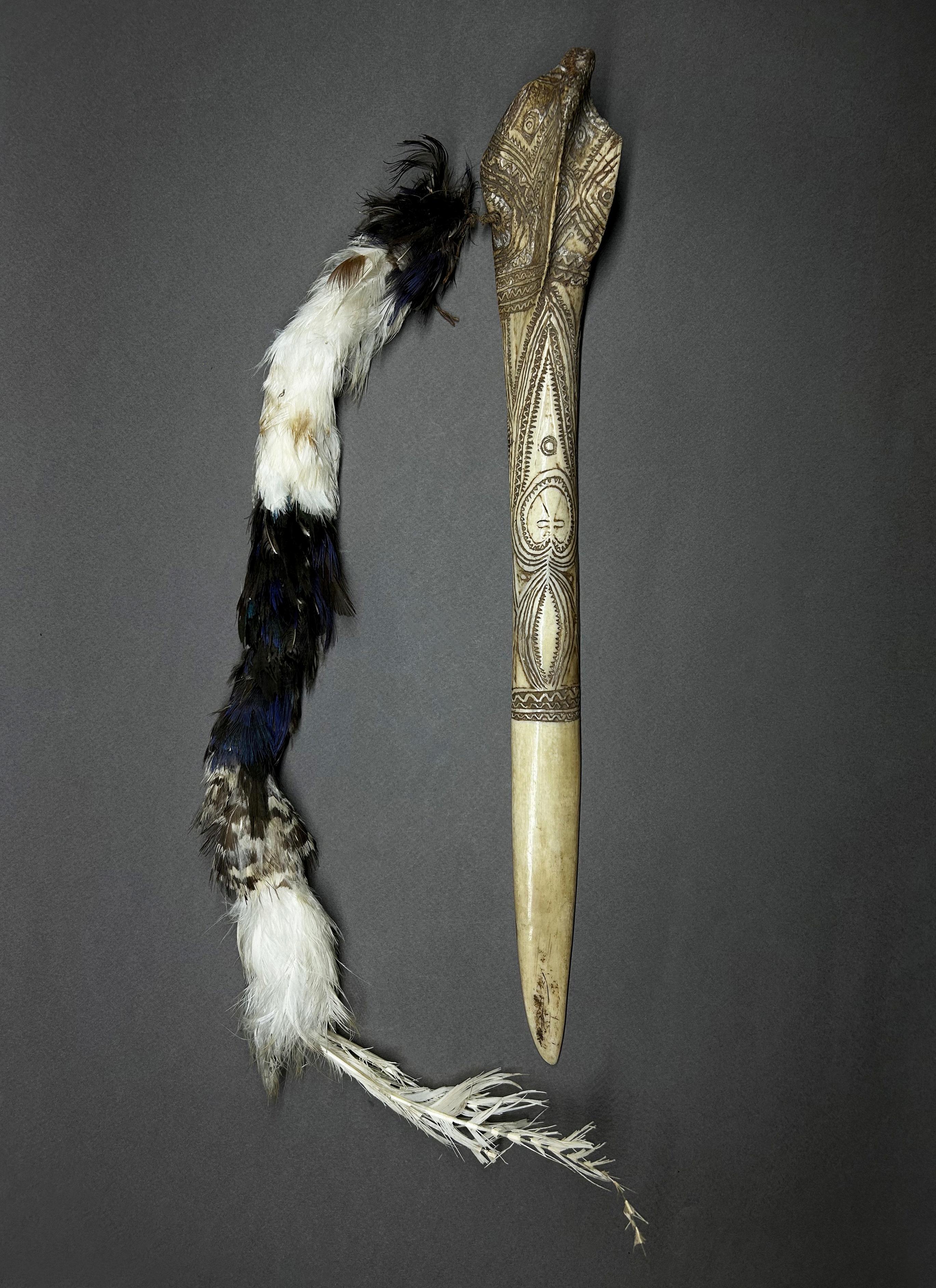

Massim region, Milne Bay, Coral Sea, PNG, Melanesia. Conus shell (Conus leopardus or millepunctatus), Ovula ovum, banana seeds, pandanus leaf, vegetable fiber cord +/- 67 x 13 cm 19th-20th century. Provenance: Collected in the field by Jacques & Betty-Paule Villeminot during their trip to Massim country in 1966 Ex Jacques (1924-2022) & Betty-Paule (1924-2015) Villeminot, France.
Important armband, or mwali, made from a large conus shell These precious objects were both worn as ornaments on the upper arm - those that could be pushed farthest up the arm were the most valuableand used as valuable exchange objects in the famous Kula exchange system studied by Bronislaw Malinowski between 1915 and 1918 The mwali, considered a feminine object, was exchanged counter-clockwise through the network of islands, unlike the soulava and bagi necklaces, considered masculine, which circulated clockwise The mwali shown here is complete with 4 shells in a row and pendants made of pandanus fiber and banana seeds
The Kula network encompassed 18 island groups in the Massim archipelago, including the Trobriand Islands far to the north, and involved thousands of individuals. Participants traveled by canoe on expeditions specifically organized for the exchange of Kula valuables. If the opening gift between partners was an armband, the closing gift would be a necklace, and vice versa. Modes of participation and exchange varied according to the island group concerned
Gulf of Papua, PNG, Melanesia. Pandanus fiber and shells (8 Ovula ovum and 14 conus discs).
69 x 21 cm
20th century
Purchased in the former Hanua Crafts store in Port Moresby in 1987 for 76 kinas
Flat-weave fiber bag decorated with a large number of shells indicating the owner's wealth and status The shells surrounding the bag opening are Ovula ovum, while the body of the bag and its strap are decorated with large disks cut from the head section of conus shells

Tolai, New Britain, PNG, Melanesia Fiber, rattan, nassa shells
80 Ø cm.
19th-20th century. Ex private collection.
A very large complete roll of currency called diwarra or tabu Currency of this size is made from around ten thousand tiny, calibrated nassa shells (Nassariidae), which are pierced and threaded onto lengths of rattan These shells are called palakanoara in the local language. They are the most important type of currency in Tolai culture and, unlike other types of ceremonial money, diwarra can be fragmented and used as a method of payment in everyday transactions.
"The standard unit of tabu money is a param - a rope the length of an adult's arm, or about 300 shells Tabu derives its economic value from the effort required to produce it, and acquires its cultural value by changing hands during numerous rituals and ceremonies ( ) Shell money, when freshly made, is regarded with suspicion - to make it sacred and dispel the bad magic associated with dead shells, the owner must perform a ritual. The Tolai generally reserve newly minted currency for ceremonies or the traditional payment of large fines It must undergo at least one death ritual before it can be used as ordinary currency for everyday household goods " (Martin Maden in The Spiritual Shell Money of Papua New Guinea, Claudio Sieber & Shanna Baker in https://hakaimagazine com/videos-visuals/cash-with-spiritual-currency/ Exhibition / Publication : Monnaies & Merveilles. La Monnaie de Paris, Silvana Editoriale, Milano, 2022, p. 125
Ref : Lautz, T : FEDERGELD UND MUSCHELKETTEN Geldgeschichtliches Museum der Kreissparkasse, Köln 1992



Thank you : Gisèle Bertin (Director Galerie Meyer), Vairea Anania (Apprentice) & Ranihei Prokop (Intern)
Layout : Vairea Anania assisted by Ranihei Prokop.
Photos : Michel Gurfinkel, Paris ; Galerie Meyer, Paris
Base Maker : Atelier Punchinello & Manuel Do Carmo.
Restorer : Serge Dubuc
Proofreader : Mariette Naboulet
We have made every effort to ensure the correct copyright procedure If you believe that your copyright has not been properly asserted, please contact Galerie Meyer - Oceanic Art, Paris. No part of this publication may be reproduced or published in any form or by any means without express written permission
This catalog © Galerie Meyer - Paris, is published in digital format and can be consulted free of charge at any time on the WWW ISSUU COM platform and on WWW MEYEROCEANIC ART
JP MEYER
Galerie Meyer - Oceanic & Arctic Art
17 Rue des Beaux-Arts Paris 75006 France
Tel : + 33 1 71 60 14 71 Mob : + 33 6 80 10 80 22 ajpmeyer@gmail.com www.meyeroceanic.art
© Galerie Meyer - Oceanic & Arctic Art
No part of this publication may be reproduced, stored in a retrieval system, or transmitted, in any form or by any means, electronic, mechanical or photocopy.
